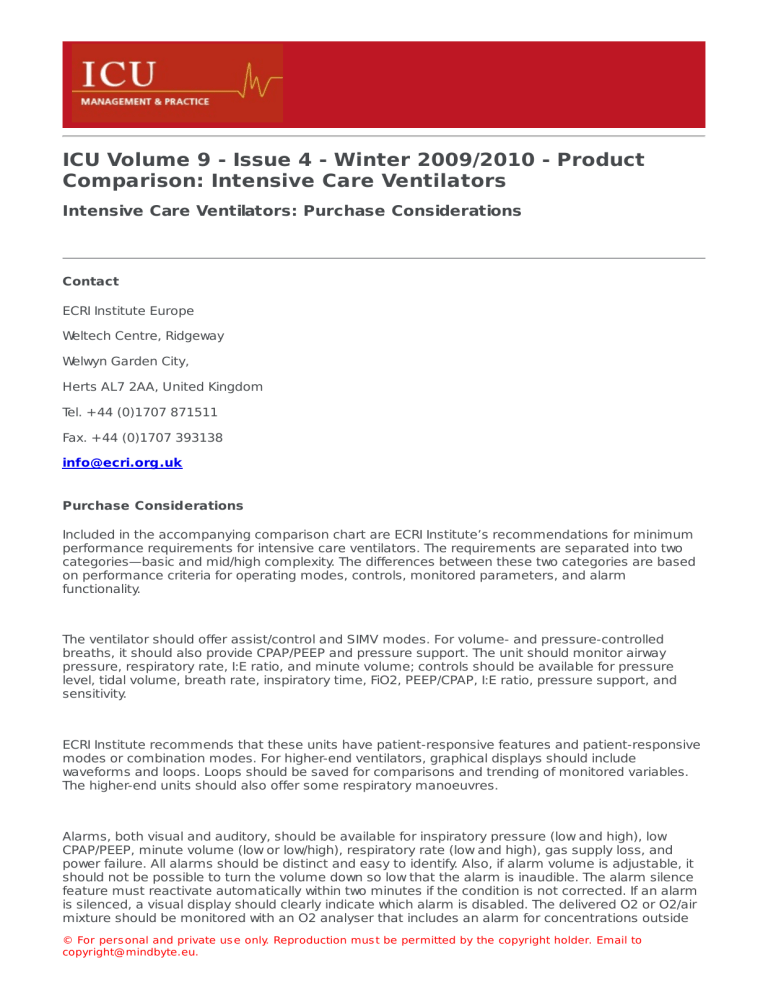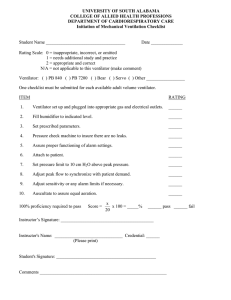
ICU Volume 9 - Issue 4 - Winter 2009/2010 - Product Comparison: Intensive Care Ventilators Intensive Care Ventilators: Purchase Considerations Contact ECRI Institute Europe Weltech Centre, Ridgeway Welwyn Garden City, Herts AL7 2AA, United Kingdom Tel. +44 (0)1707 871511 Fax. +44 (0)1707 393138 info@ecri.org.uk Purchase Considerations Included in the accompanying comparison chart are ECRI Institute’s recommendations for minimum performance requirements for intensive care ventilators. The requirements are separated into two categories—basic and mid/high complexity. The differences between these two categories are based on performance criteria for operating modes, controls, monitored parameters, and alarm functionality. The ventilator should offer assist/control and SIMV modes. For volume- and pressure-controlled breaths, it should also provide CPAP/PEEP and pressure support. The unit should monitor airway pressure, respiratory rate, I:E ratio, and minute volume; controls should be available for pressure level, tidal volume, breath rate, inspiratory time, FiO2, PEEP/CPAP, I:E ratio, pressure support, and sensitivity. ECRI Institute recommends that these units have patient-responsive features and patient-responsive modes or combination modes. For higher-end ventilators, graphical displays should include waveforms and loops. Loops should be saved for comparisons and trending of monitored variables. The higher-end units should also offer some respiratory manoeuvres. Alarms, both visual and auditory, should be available for inspiratory pressure (low and high), low CPAP/PEEP, minute volume (low or low/high), respiratory rate (low and high), gas supply loss, and power failure. All alarms should be distinct and easy to identify. Also, if alarm volume is adjustable, it should not be possible to turn the volume down so low that the alarm is inaudible. The alarm silence feature must reactivate automatically within two minutes if the condition is not corrected. If an alarm is silenced, a visual display should clearly indicate which alarm is disabled. The delivered O2 or O2/air mixture should be monitored with an O2 analyser that includes an alarm for concentrations outside © For pers onal and private us e only. Reproduction mus t be permitted by the copyright holder. Email to copyright@mindbyte.eu. mixture should be monitored with an O2 analyser that includes an alarm for concentrations outside acceptable ranges. The analyser should be included with the ventilator. The controls (i.e., switches, knobs) should be visible and clearly identified, and their functions should be self-evident. The design should prevent misinterpretation of displays and control settings. Controls should be protected against accidental setting changes (e.g., due to someone brushing against the panel) and be sealed against fluid penetration. Patient and operator safety and system performance should not be adversely affected by fluid spills. Cost Containment Because intensive care ventilators entail ongoing maintenance and operational costs, the initial acquisition cost does not accurately reflect the total cost of ownership. Therefore, a purchase decision should be based on issues such as life-cycle cost (LCC), local service support, discount rates and non-price-related benefits offered by the supplier, and standardisation with existing equipment in the department or hospital (i.e., purchasing all ventilators from one supplier). Hospitals should evaluate how they plan to use the ventilator; in particular, the decision to use disposable or reusable breathing circuits will affect the cost of operation. Hospitals can purchase service contracts or service on a time-and-materials basis from the supplier. Service may also be available from a third-party organisation. The decision to purchase a service contract should be carefully considered. Purchasing a service contract ensures that preventive maintenance will be performed at regular intervals, thereby eliminating the possibility of unexpected maintenance costs. Also, many suppliers do not extend system performance and uptime guarantees beyond the length of the warranty unless the system is covered by a service contract. ECRI Institute recommends that, to maximize bargaining leverage, hospitals negotiate pricing for service contracts before the system is purchased. Additional service contract discounts may be negotiable for multiple-year agreements or for service contracts that are bundled with contracts on other similar equipment in the department or hospital. Stage of Development The mid-1980s witnessed the introduction of microprocessor-based ventilators that could be easily upgraded to perform additional operations by a simple software change. However, the use of microprocessors has given the operator a vast and sometimes confusing number of options to choose from. In the near future, monitors for gas exchange and haemodynamics may be merged with the ventilator’s existing data collection system. This combined system may alert the clinician to necessary control changes. Recently, the concept of tracheal triggering was introduced. Tracheal pressure triggering has substantially reduced the work of breathing in lung models simulating spontaneous breathing with CPAP. This reduction occurs because a small level of pressure support is produced at the proximal endotracheal tube. Tracheal triggering may also be beneficial when small endotracheal tubes are used. For more information, visit www.ecri.org Published on : Thu, 15 Aug 2013 © For pers onal and private us e only. Reproduction mus t be permitted by the copyright holder. Email to copyright@mindbyte.eu.

